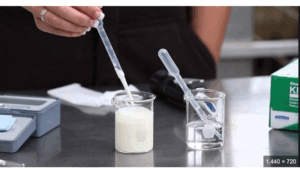LITMUS PAPER TEST
The litmus milk test is used to differentiate bacteria based on their ability to ferment lactose, reduce litmus, and digest milk proteins (casein). The medium contains litmus (pH/redox indicator) and milk (lactose and casein).
Key Reactions:
Acid reaction: Pink color — lactose fermentation
Alkaline reaction: Blue color — protein breakdown
Litmus reduction: White color — anaerobic conditions
Proteolysis: Clear/brown medium — casein digestion
Stormy fermentation: Cracks/fissures — gas production
LACOMETER TEST

How It Works:
A lactometer measures the specific gravity (density) of milk, which helps detect adulteration, especially water dilution.
Steps:
Pour milk into a tall, clean cylinder.
Gently place the lactometer into the milk.
Read the scale at the milk’s surface level.
Interpretation:
Normal range: 1.026 – 1.032
(i.e., 26–32 on most lactometer scales)Below 1.026 → Possible water added (milk diluted)
Above 1.032 → Possible addition of solids (like starch or sugar)
FLOW TEST

A flow test for milk purity is a quick, low-cost physical test used to check for milk adulteration or dilution. Here’s how it’s generally performed:
🧪 Basic Flow Test for Milk Purity
Materials Needed:
A clean glass plate or a smooth inclined surface
A dropper or spoon
The milk sample
Procedure:
Take a clean, dry glass plate and hold it at a slight angle (around 30–45°).
Using a dropper or spoon, put a drop of milk on the plate.
Observe the way the milk flows down the plate.
Interpretation of Results:
| Observation | Possible Indication |
|---|---|
| Milk flows slowly and leaves a white trail | Likely pure milk – contains normal fat and solids |
| Milk flows quickly and leaves no mark | May be diluted with water or lacks fat |
| Milk appears watery or thin | Indicates possible adulteration or low SNF (Solids-not-fat) |
